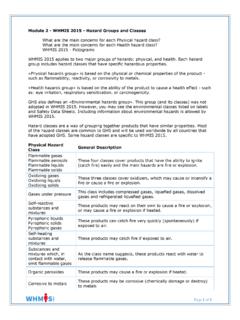Transcription of Module 1 - Overview of WHMIS 2015 What is WHMIS?
1 Page 1 of 3 Module 1 - Overview of WHMIS 2015 what is WHMIS ? what are the main elements in WHMIS ? what is GHS? what are the main elements in GHS? Key Terms in GHS Vocabulary what is WHMIS ? The Workplace Hazardous Materials Information System, or WHMIS as it is called, is a national system designed to ensure that all employers obtain the information that they need to inform and train their employees properly about hazardous materials used in the workplace. WHMIS was developed jointly by labour, industry and federal, provincial and territorial governments. WHMIS came into force all across Canada on October 31, 1988 by a combination of federal and provincial legislation. On February 11, 2015 , the Government of Canada published the Hazardous Products Regulations (HPR), which, in addition to the amendments made to the Hazardous Products Act, modified WHMIS to incorporate the Globally Harmonized System of Classification and Labelling of Chemicals (GHS) for workplace chemicals.
2 This modified WHMIS is referred to as WHMIS 2015 . what are the main elements in WHMIS ? While WHMIS 2015 includes new harmonized criteria for hazard classification and requirements for labels and safety data sheets (SDS), the roles and responsibilities for suppliers, employers and workers have not changed. Suppliers, defined as persons who, in the course of business, sell or import a hazardous product, will continue to: identify whether their products are hazardous products; and, prepare labels and SDSs and provide these to purchasers of hazardous products intended for use in a workplace. Employers will continue to: educate and train workers on the hazards and safe use of hazardous products in the workplace; ensure that hazardous products are properly labelled; prepare workplace labels and SDSs (as necessary); and, ensure appropriate control measures are in place to protect the health and safety of workers.
3 Page 2 of 3 Workers will continue to: participate in WHMIS and chemical safety training programs; take necessary steps to protect themselves and their co-workers; and, participate in identifying and controlling hazards. what is GHS? The Globally Harmonized System of Classification and Labelling of Chemicals (GHS) is an internationally consistent approach to classifying chemicals and communicating hazard information through labels and safety data sheets. The key objectives of the GHS are: To increase worker protections through the adoption of an improved, globally recognized standard for communicating the hazards associated with workplace hazardous chemicals. To facilitate trade through common labelling and other hazard communication requirements; and To lower costs for businesses and consumers by reducing the need for retesting and reclassifying workplace hazardous chemicals from, or for, different markets.
4 what are the main elements in GHS? The two major elements of GHS are: 1. Classification of the hazards of chemicals 2. Communication of the hazards and precautionary information what are some key terms in the GHS Vocabulary? SDS - Safety Data Sheet is the term used by GHS for Material Safety Data Sheet (MSDS) Hazard group - GHS divides hazards into three major groups - health, physical and environmental. Class - the term used to describe the different types of hazards Category - the name used to describe the sub-sections of classes. Categories are assigned numbers (or letters) with category 1 (or A) being the most hazardous. Hazard Statement - For each category, a standardized statement is used to describe the hazard. This hazard statement would appear both on the label and on the SDS.
5 Precautionary Statement - Standardized phrases that describe the recommended steps to be taken to minimize or prevent adverse effects from exposure to or resulting from improper handling or storage of a hazardous product. Page 3 of 3 Signal word - There are two signal words in the GHS system - Danger and Warning. These signal words are used to communicate the level of hazard on both the label and the SDS. Pictogram - Pictogram refers to the GHS symbol on the label and SDS. Not all categories have a symbol associated with them.

